Ladybugs are small colorful beetles often associated with good luck and romance. They grow up to 18mm and they can be spotted.
Ladybugs are often associated with certain meanings. These colorful small beetles symbolize good luck, love, friendliness, or new beginnings, depending on their color.
Red is the common most people associate ladybugs with. While red ladybugs are common, orange ladybugs are also seen frequently in the summer.
Ladybugs also come in many other colors and color combinations. Most ladybugs also exhibit black or red spots on the elytra or wings.
Table of Contents
What Colors do Ladybugs Come In?
Ladybugs are often assumed to only come in red due to the popularity of the Red ladybug in culture. But they come in a few different colors as follows.
- Red – is one of the most common types of colors for ladybugs in cultures around the world.
- Yellow – differentiated by black spots on their bodies, yellow ladybugs are seen on almost all continents.
- Orange – is the most common type of ladybug coloring after red and yellow.
- Black – mostly known for a black body with red spots, these ladybugs are perceived as more poisonous than red ladybugs.
- Gray – mostly common in North America.
- Blue – mostly metallic blue.
- Brown – best at camouflaging and the least toxic ladybug by color.
- White – a rare color.
- Pink – also a rare color in ladybugs.
Why Do Ladybugs Have Different Colors?
Ladybugs have different colors for defensive purposes. Their colors are the result of adaptation and evolution, especially when it comes to their relation to predators such as various birds.
Ladybugs don’t have any real defensive mechanisms (apart from releasing bad odors and tasting bad) to keep off predators by their looks.
Since ladybugs can be as small as 0.8mm, they need to appear toxic to predators.
To appear poisonous
Ladybugs have vivid spotted coloring to appear poisonous. This is not just a supposition as research shows ladybugs have vivid colors that make predators think of them as poisonous while moving on.
A red or a yellow ladybug with black spots mostly appears poisonous to birds, frogs, and other common ladybug predators. These bright colors vary from species to species.
Furthermore, the coloring of ladybugs isn’t constant throughout their lives. Older ladybugs are known for having a more faded color which might not work in their favor when it comes to keeping predators away.
For better camouflage
Camouflaging colors are rare in the world of ladybugs mostly known for their bright colors. However, certain species such as the brown ladybird or the gray ladybird have superior camouflage.
Brown ladybirds are known to blend in with their surroundings. This keeps off more potential predators.
Why do ladybugs have spots?
Some ladybugs have spots but there are species with no spots at all. One of the common misconceptions people have about spots is that they indicate the age of ladybugs. This is not the case.
Another common misconception about ladybug spots is that they indicate the number of babies you can have. This is false as well.
Warning for predators
Ladybugs have spots that can act as warning signs to potential predators.
Some farmers believe the more black spots a ladybug has the better the harvest for the season. However, these spots can potentially signal predators of a poisonous bug which makes them stay away.
Aposematic coloration in ladybugs
Ladybugs are part of the animal kingdom where aposematic coloration is used for defense. This is a type of body color that signals to predators a bug or an animal isn’t worth pursuing due to its potentially poisonous body.
Aposematism in ladybugs refers to the perceived toxicity, venomous nature, or bad taste these species have to predators.
As a result, the ladybug coloration is a warning coloration. It signals potential predators of a potentially bad meal or even a potentially deadly meal.
Aposematism is believed to be good both for predators and for ladybugs. Predators stay away from these bugs and other poisonous bugs and ladybugs get to survive more predation attempts.
Meanings of Different Ladybug Colors
Different ladybug colors have different meanings. There aren’t many bugs that are so full of meaning in popular culture than ladybugs.
1. Red Ladybugs
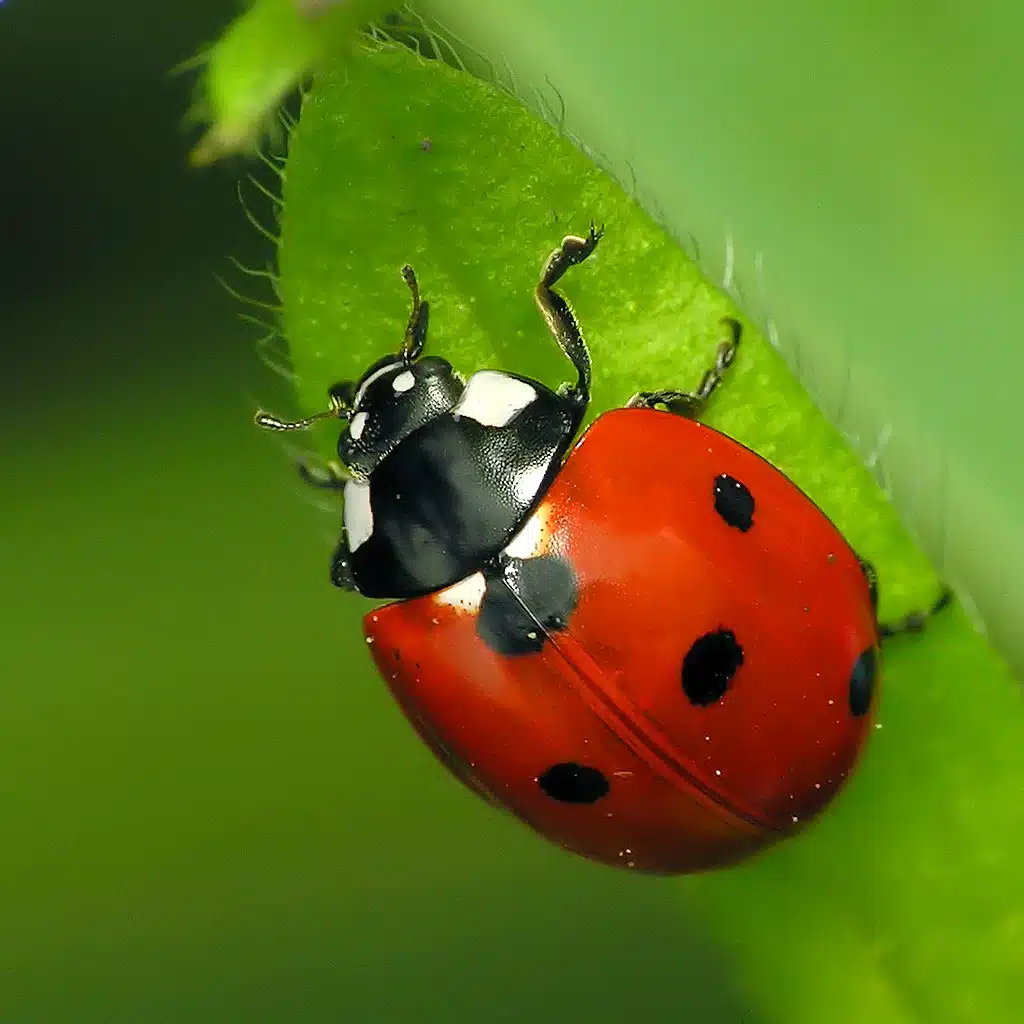
Red ladybugs such as Coccinella septempunctata represent the most common coloring of the species. Most people are aware of these bugs.
When it comes to the portrayal of ladybugs in the media, red ladybugs tend to get the spotlight over all other colors. Here’s what their coloring stands for.
- Love and romance
Red is the color of love. Red ladybugs are firstly associated with romantic love. This is why many couples see a red ladybug as a symbol of their feelings.
Red ladybugs are associated with the love to come for singles. Whenever a single person sees a red ladybug it’s expected of them to meet their partner soon.
Romance is identified by red ladybugs even if they have black spots. The added black markings on the elytra are the contrasting color often to a lesser extent compared to the actual red base color.
- Long-term partnership
Red ladybugs are also believed to bring good fortunes in long-term relationships.
Meeting a partner is just the first part but being with a partner for a long time is believed to be influenced by red ladybugs in some cultures around the world.
- Friendship
Red ladybugs are also associated with friendship. It might not be a romantic friendship at first but it certainly has the potential to become a romantic relationship in the future.
2. Orange Ladybugs
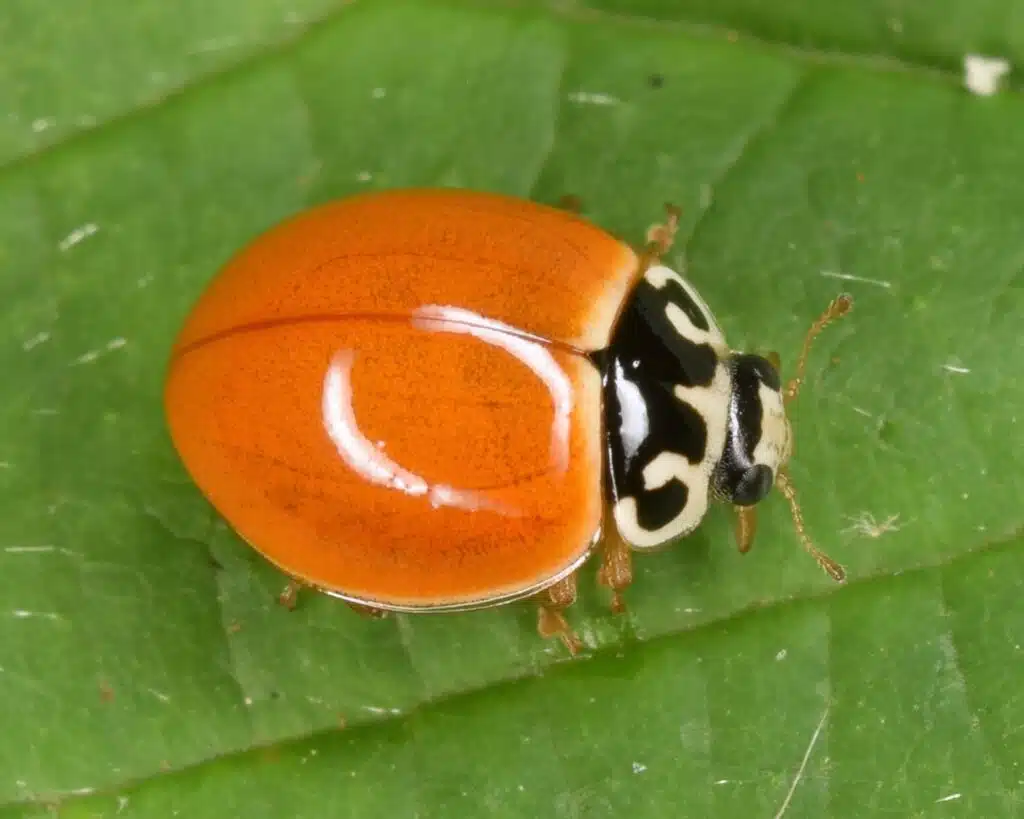
Orange ladybugs are common, albeit not as common as red ladybugs. Orange is a vibrant color that inspires the inner spirit to pursue its passions.
While orange ladybugs certainly look poisonous, they aren’t poisonous. They’re associated with new projects and imagination.
- Creativity
Seeing orange ladybugs is a sign that creativity will or needs to follow. Creativity is expressed through multiple means.
The creative outlet inspired by orange ladybugs doesn’t involve romance. However, it involves reaching professional and personal goals through unique or interesting methods.
Creative sparks aren’t common as a meaning in the ladybug world. As a result, seeing an orange ladybug such as the Asian ladybeetle (Harmonia axyridis) is tied to imaginative or even unique methods of resolving certain problems.
- Prosperity
Prosperity is only associated with orange ladybugs. Wealth and well-being aren’t associated with red or yellow ladybugs.
Seeing an orange ladybug can mean you’re about to prosper in your career or otherwise in your personal life.
- Opportunities
Orange is also the color of opportunities. Most opportunities can be tied to prosperity. But others are tied to learning or new experiences.
Seeing an orange ladybug can be significant new opportunities to learn, travel, or meet people arise.
3. Yellow Ladybugs
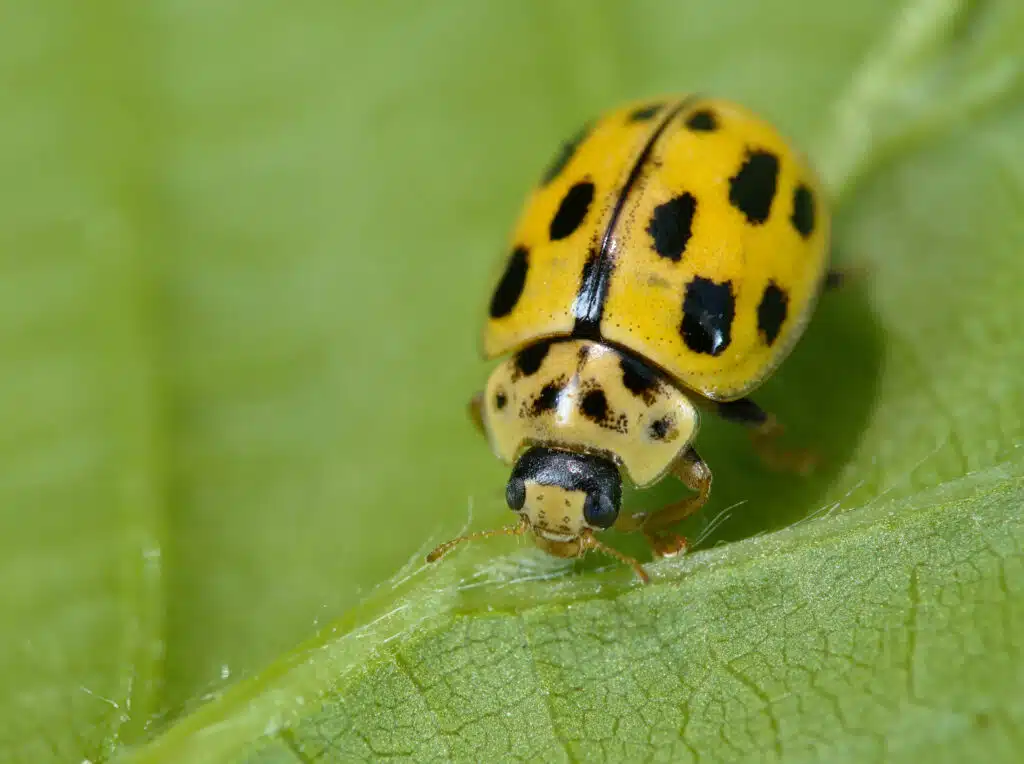
Yellow ladybugs such as the 22-Spot ladybug are increasingly common across the world. Yellow might be a sign of betrayal in some cultures but yellow ladybugs are only tied to positive feelings and occurrences.
Yellow ladybugs may or may not exhibit spots or black markings.
Species such as the Fourteen-spotted ladybug are known to have large black markings that merge. These markings are so large that the yellow ladybug appears more like a black-yellow ladybug.
- New beginnings
Yellow ladybugs might be the signal new beginnings are coming. These new beginnings can be tied to a new job, a promotion, or the opportunity to move with your job.
Seeing yellow ladybugs is also tied to the new beginnings on a personal level. Getting fit or improving your health can be associated with seeing yellow ladybugs in certain cultures.
4. Black Ladybugs
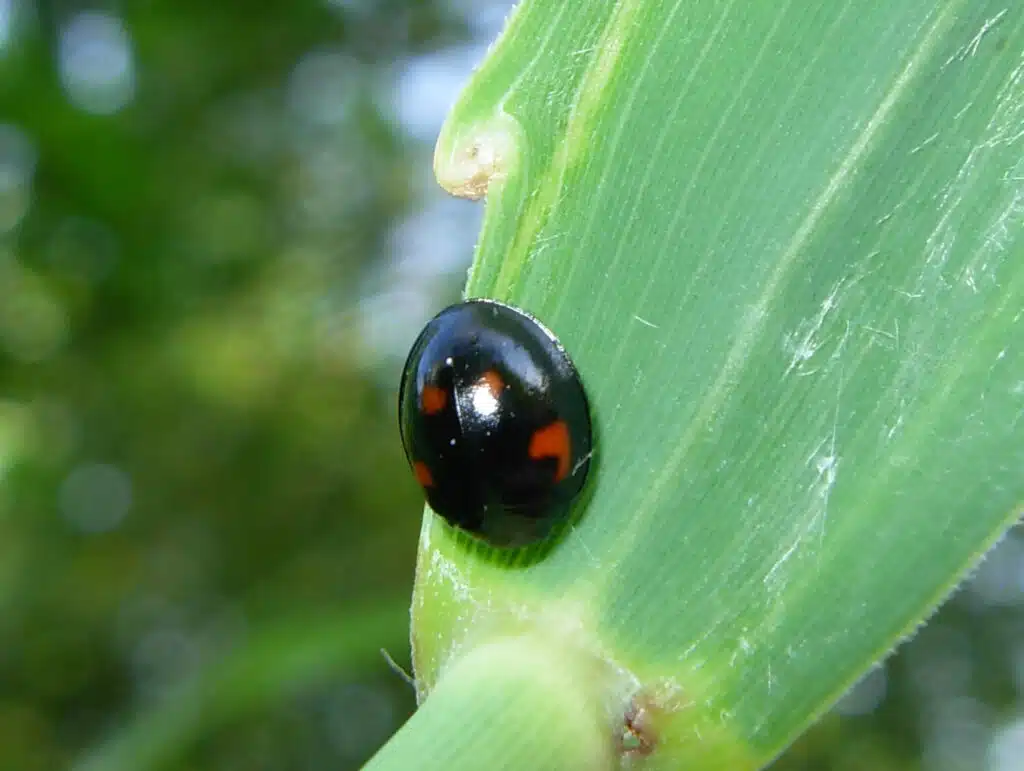
Black ladybugs such as Pine ladybirds are increasingly seen as poisonous. They’re also tied to positive meanings and rarely tied to bad occurrences.
- Introspection
Black ladybugs signal introspecting and self-analysis. Seeing a black ladybug is believed to be a time to analyze yourself from different perspectives.
Black ladybugs are believed to be some of the most meaningful ladybugs in terms of self-growth.
- Self-love
Seeing a black ladybug is also a clear sign you need to practice self-love. One of the first steps towards living a wholesome life is being happy and this may only start by loving yourself first.
Those seeing a black ladybug are often believed to be people that need a sign to love themselves more according to some beliefs.
- Emotions
Black ladybugs are tied to all types of emotions except romance. These emotions are mostly good, but they can come from negative experiences.
Seeing a black ladybug can also be a signal you need to see new beginnings even after the most complicated and hurtful events in your life.
5. White Ladybugs
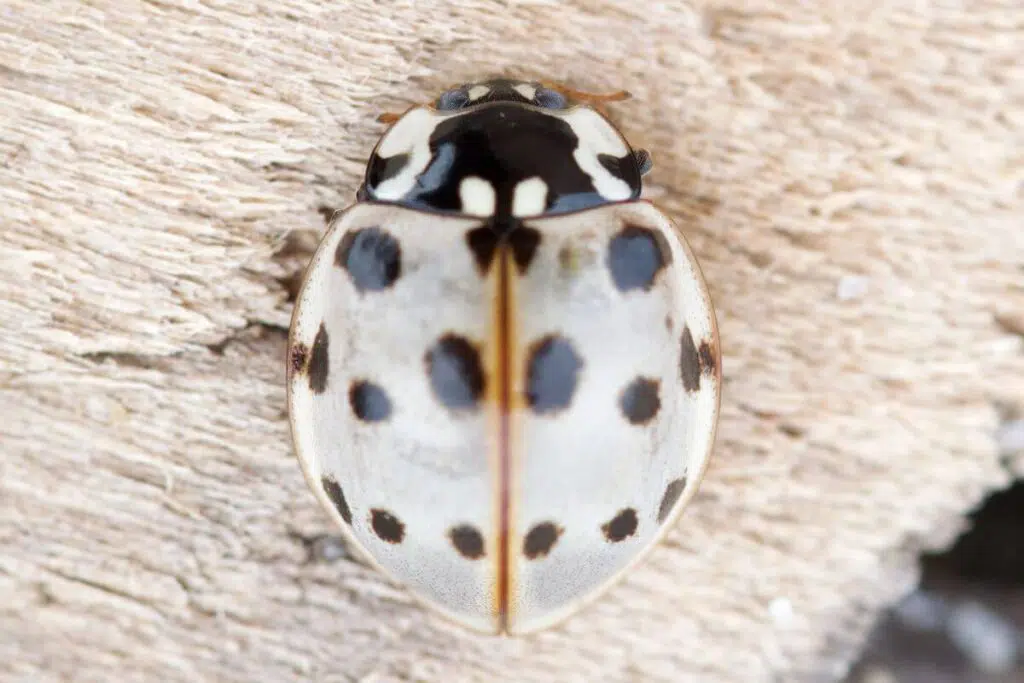
There are only 3 species of white ladybugs. Their scarce population makes them special in the world of ladybugs. Seeing a bug such as Albino Ladybug is a sign peace is upon you.
- Purity
Purity is one of the first interpretations of seeing a white ladybug. You might need to live a pure life or you might already live a pure life whenever you see one of these white ladybugs according to common meanings interpretation.
- Peace
White ladybugs are tied to feelings of peace. Often dominated by conflict or disagreements, people need to be reminded of peace and tranquility both on the inside and in relationships with others.
- Faith
White ladybugs also symbolize faith. Seeing these ladybugs is a sign that you need to put your trust in someone and that many problems will resolve themselves.
6. Blue Ladybugs
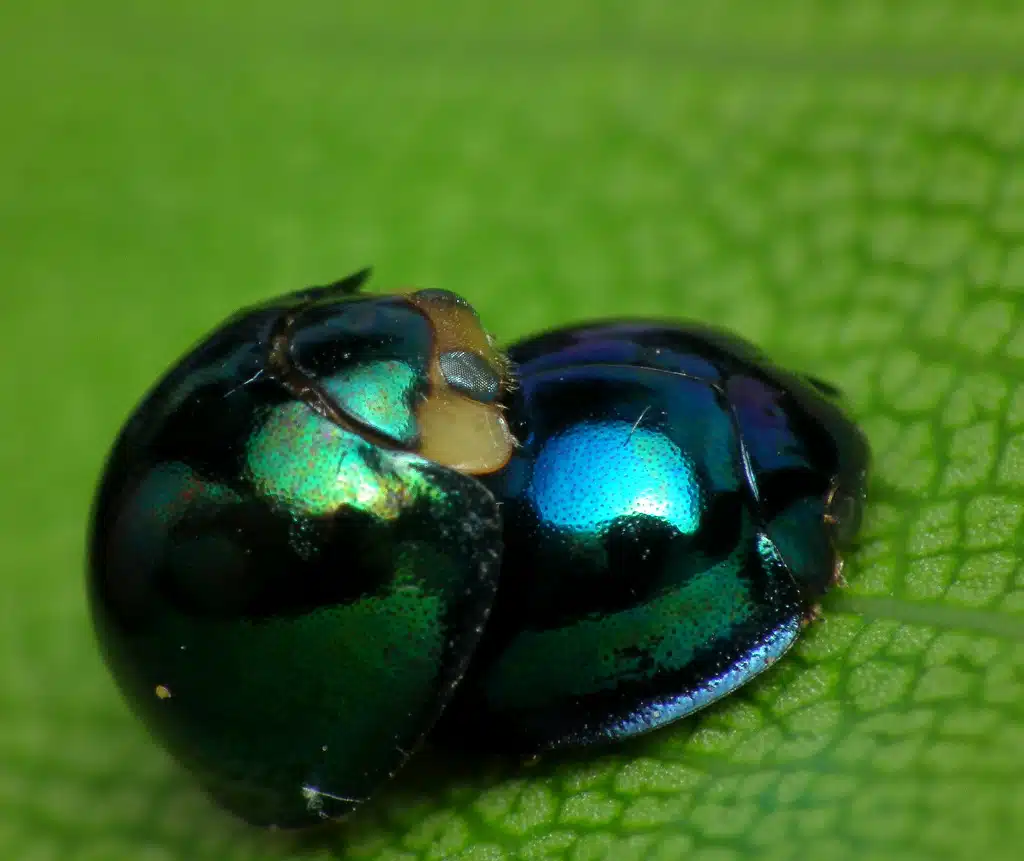
Blue ladybugs are rare but interesting. Steelblue ladybugs (Halmus chalybeus) are among the most intriguing ladybugs. Wisdom is one of the meanings of seeing these ladybugs.
- Calmness
Blue involves calmness. Seeing a blue ladybug might mean you need to live a calmer life. This might mean spending more time at home and less at work or generally avoiding conflict to live a calmer life.
- Stability
Blue ladybugs are also associated with feelings of stability. Living a calmer life means living a stable life. Stability is an essential value for individual growth and family growth.
- Wisdom
Blue ladybugs are also associated with wisdom. Seeing a blue ladybug might be an indication you need to plan and generally think about a situation more or act out of impulse less.
7. Brown Ladybugs
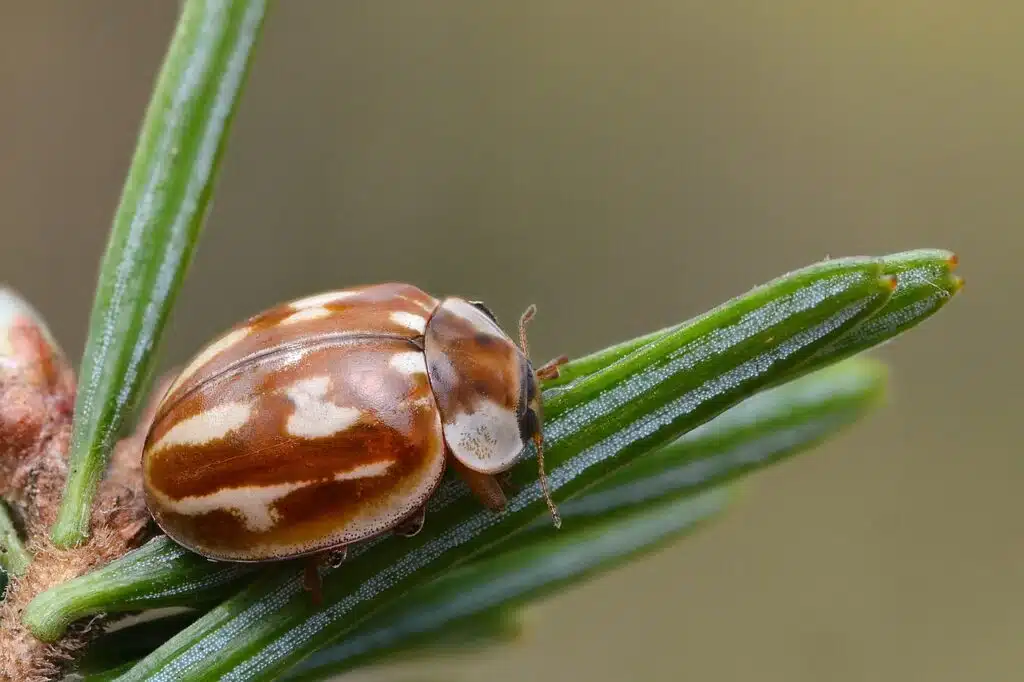
Brown ladybugs are very good at hiding as they have a camouflage color. These ladybugs are also full of meaning.
- Resilience
Resilience or perseverance is tied to brown ladybugs. You need to work harder or to try again either in love or in your career whenever you see a brown ladybug according to popular belief.
- Security
Feelings of security are generally tied to brown ladybugs. A secure life is a protected life. You might need to protect a person or to protect yourself more whenever you see a brown ladybug.
- Dependability
Being a person others can depend on is an important quality. It’s also believed you need to be more dependable whenever you see a brown ladybug.
8. Pink Ladybugs
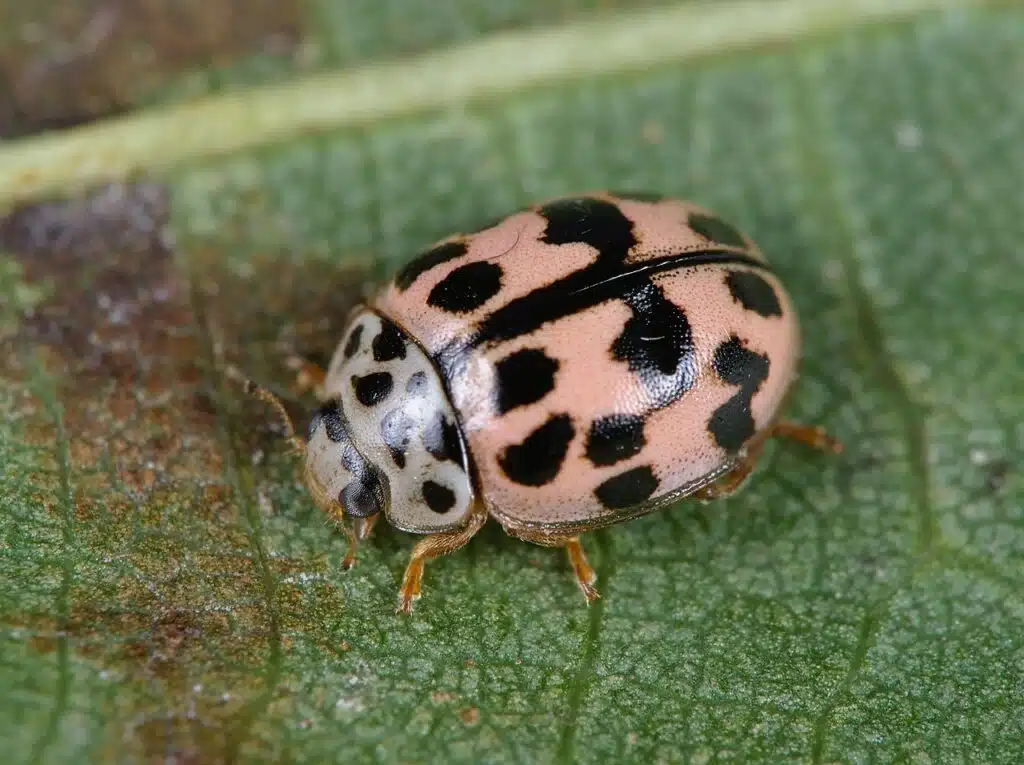
Pink ladybugs are rare. They offer an interesting sight full of meaning. The coloring of these bugs is often interpreted as extreme friendliness.
The Pink-spotted ladybeetle is known for being partially pink. These ladybugs have very large black spots, some of the largest in the ladybug world.
A body that has a partially pink color and large black spots are clear warning signs for predators that can see it from a long distance.
- Love
Friendly (not romantic) love is associated with pink ladybugs. Seeing a pink ladybug such as the Pink Ladybird beetle (Coleomegilla maculate) is believed to suggest the idea you need to love others around you more.
- Femininity
Feelings of femininity are often associated with pink ladybugs. These involve a certain level of gentleness or care. You might need to embrace your feminine side more whenever you see a pink ladybug.
- Kindness
Kindness is also closely tied to pink ladybugs. These ladybugs suggest being kinder to a larger extent compared to yellow ladybugs.
9. Gray Ladybugs
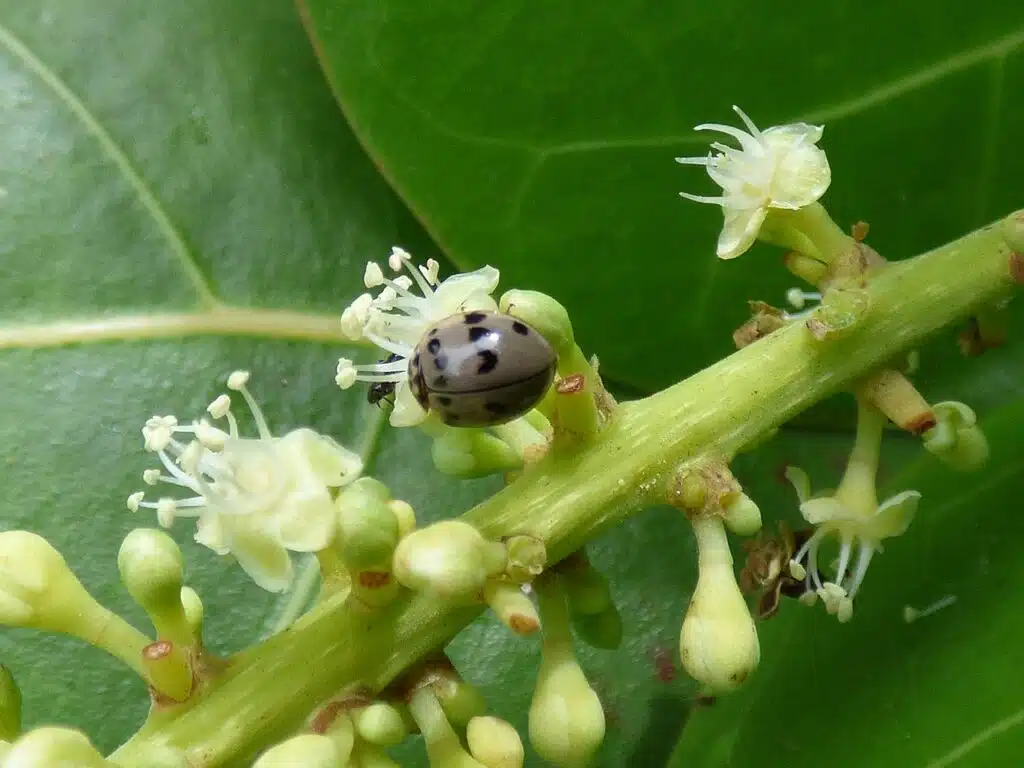
Gray ladybugs such as the Ashy Gray Lady Beetle are common in North and South America. These ladybugs have a very specific meaning, often tied to uniformity.
Gray ladybugs such as the Fifteen-spotted ladybeetles are known for also showing black spots on the body.
As on vividly-colored ladybugs, these black spots as warning signs for predators. Both the Ash Gray and the Fifteen-spotted ladybeetles are known to keep predators away through these black spots.
- Wisdom
Gray ladybugs are a signal of wisdom. Seeing one might mean you’re already a wise person or that you need to be wiser about certain decisions.
However, seeing a gray ladybug might be a special event in itself due to the scarcity of these ladybugs in some parts of the world.
- Uniformity and simplicity
Gray ladybugs are also tied to the idea of simplicity. Living a minimalist lifestyle is often the main idea you can think about whenever you see a gray ladybug.
Alternatively, you might also consider blending in more or refraining from outrageous acts whenever you see a gray ladybug.
- Awareness
Seeing a gray ladybug can also be tied to feelings of awareness. You might be more aware of what’s happening in your life or you might be more aware of what’s happening around you.
Whatever the case, it’s clear a certain level of awareness is tied to gray ladybugs as a form of wisdom.
What Ladybug Color is Poisonous?
Ladybugs are often perceived as poisonous bugs due to their coloring. None of the colored ladybugs are truly poisonous, however.
A sticky defensive honeydew
Ladybugs are often believed to be poisonous as they release a sticky substance.
This is ladybug honeydew which might make some predators such as spiders stay away from these bugs as they even cover plant leaves in it.
Bad taste in hemolymph
The bad taste of ladybugs is already something predators such as birds are aware of. This bad taste comes from a blend of chemicals in the hemolymph or the blood system of the bugs.
Bad-tasting ladybugs aren’t very attractive to predators. This bad taste might be interpreted as a poison by some animals trying to eat these bugs.
What Is The Most Common Ladybug Color?
Red is the most common ladybug color. Red ladybugs are seen everywhere.
The Seven-Spotted Ladybug is the most common species of ladybugs in North America. This red bug is often portrayed in the media in movies and cartoons based on its common friendly look.
Orange ladybugs are also common, but not as common as red ladybugs.
What is The Rarest Ladybug Color?
Tan is the rarest ladybug color. There are only 2 tan ladybug species. One of them is the Asian ladybug which also comes in a tan color, but very rarely.
Tan ladybugs are some of the most difficult to spot in North America. They might only seek out warm indoor temperatures at the end of summer as the temperature starts to drop.
Do Male and Female Ladybugs Vary In Colors?
Ladybugs are sometimes believed to be female-only due to their name. But ladybugs are both male and female.
It can be difficult to spot visible differences between males and females apart from size as females tend to be larger.
The elytra or the wings of male and female ladybugs have similar colors. However, parts of the head and the mouth are lighter in males compared to female ladybugs.
Male ladybugs have lighter labrums. This mouth area is darker in females. The femur of the males is also lighter than the femur areas of females.
The color of the elytra defines the color of ladybugs. But color differences are only seen in other parts of the body in ladybugs.
What Color Are Baby Ladybugs?
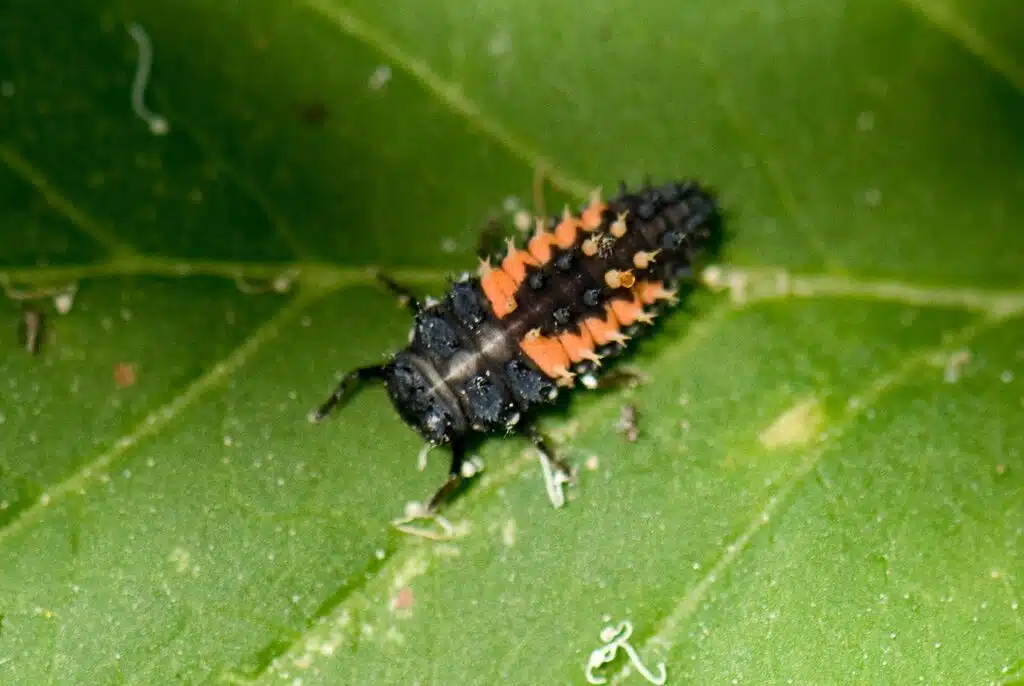
Ladybug nymphs are known for their potentially dangerous look. These nymphs aren’t dangerous to people or plants as they feed on various insects until they pupate.
Ladybug nymphs are predominantly black with orange sections of their spiny elongated body, mostly in the mid-section. They might also have red sections on their bodies.
Ladybug nymphs have a black head and black legs. They might have an orange mid-section with orange spines.
These ladybugs are rarely seen in the winter as female ladybugs lay in sheltered areas. They prefer to lay them in tree bark or even in man-made structures to survive winter. They emerge in the spring as black and orange nymphs.
Once they pupate, these turn into adult ladybugs. They then repeat the cycle laying hundreds or thousands of eggs over the summer which turn into black and orange nymphs.
What Color Are Ladybug Eggs?
Ladybug eggs are bright yellow. These eggs aren’t easy to see as they are laid in locations predators don’t see.
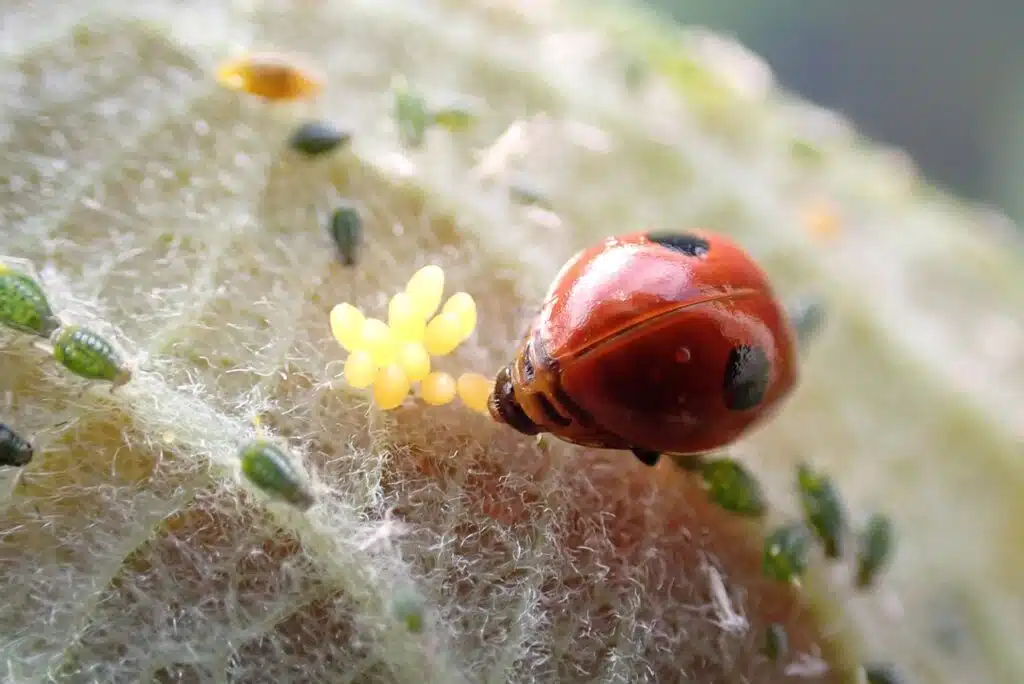
These eggs then turn into black and orange ladybug nymphs.
Many ladybug eggs are laid on the underside of leaves. Others are laid in tree bark while some eggs can even be found indoors in attics.
Female ladybugs are known to lay up to 1.000 eggs per summer. They lay bright yellow eggs multiple times per summer.
Summary
Red and black are the classic ladybug colors. This is the combination of colors most ladybugs are known for.
Orange and yellow ladybugs are also common.
Most ladybugs can be spotted but there are many spotless species as well. These spots are mostly black. Some are red.
A rare number of ladybugs are known for even having white spots (Eighteen-spotted ladybird).
It’s believed the coloring of ladybugs is mostly a form of defense under aposematic coloring which keeps predators away.
Coloring differences between males and females are rare and difficult to spot without thorough investigation.
Some color differences have been noted on the head and femur of males and females while the elytra remain as colored in males as in females.
Ladybugs are known to change colors from nymphs to adults. While eggs can be bright yellow nymphs can be black and orange.
Tan ladybugs are some of the rarest ladybugs in North America followed by gray ladybugs, and brown ladybugs. All ladybug colors are tied to specific meanings in popular belief from romance to self-discovery meanings.
Further Reading: